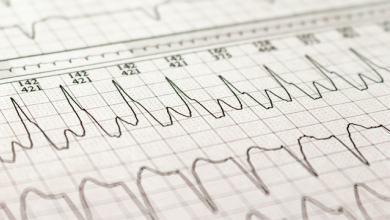Search results
Author(s):
Jorge G Panizo
,
Sergio Barra
,
Greg Mellor
,
et al
Added:
3 years ago
Premature ventricular complexes (PVCs) are the most common ventricular arrhythmia. Their prognostic significance cannot be interpreted without considering the presence or absence of any associated underlying cardiac condition. In the absence of structural heart disease, PVCs were generally considered to be benign.1,2 In the 1970s and 1980s, it was postulated that frequent PVCs could be a trigger…
View more
Author(s):
David J Callans
Added:
3 years ago
Premature ventricular contractions (PVCs) are very common cardiac arrhythmias, detected on up to 75% of Holter monitors of ambulatory patients.1 Although PVCs in the setting of advanced structural heart disease have independent negative prognostic implications,2 the majority of PVCs are quite benign, associated with neither symptoms nor signals of future harm. For an important minority, PVCs…
View more
Author(s):
Fouad Khalil
,
Konstantinos C Siontis
,
Gabor Bagameri
,
et al
Added:
3 years ago
Catheter-based ablation has been a well-established tool in the treatment of ventricular tachycardia (VT). However, the effectiveness of catheter ablation may be limited by its ability to access sites of arrhythmogenic tissue and achieve adequate lesion size in target areas without risking collateral damage. Antiarrhythmic surgery would be an effective alternative in such situations. Despite the…
View more
Author(s):
Mario Njeim
,
Frank Bogun
Added:
3 years ago
Percutaneous ablation for ventricular tachycardia (VT) was first attempted in 1983 and has rapidly evolved to become an important option for controlling recurrent VTs.1 Endocardial ablation remained the only percutaneous approach until epicardial access was introduced by Sosa et al. in 1996 and thereafter became progressively more available as an adjunctive strategy for the treatment of…
View more
Author(s):
Ethan R Ellis
,
Mark E Josephson
Added:
3 years ago
Cardiomyopathies are heterogeneous heart muscle disorders with a wide range of aetiologies and clinical manifestations. They are often defined by their causes (i.e. hypertension, prior myocardial infarction, valvular heart disease), although current major society definitions describe cardiomyopathy as the presence of abnormal myocardial structure and/or function in the absence of underlying…
View more
Author(s):
Gonca Suna
,
Greg J Mellor
Added:
4 months ago
Author(s):
Benedict Wiles
,
Anthony C Li
,
Michael C Waight
,
et al
Added:
1 year ago
Wide Complex Tachycardia
Author(s):
John B Garner
,
John M Miller
Added:
3 years ago
Article
Author(s):
Josef Kautzner
,
Petr Peichl
Added:
3 years ago
Ventricular fibrillation (VF) is a complex arrhythmia that leads invariably to cardiac arrest. Its mechanisms remain largely unclear. Similar to atrial fibrillation, the mother rotor hypothesis is one plausible alternative.1,2 In larger animals, some authors reported that the dominant frequency of VF could be recorded at a junction of the left ventricular posterior wall and the septum.3-6 Others…
View more
Author(s):
Jeffrey J Hsu
,
Ali Nsair
,
Jamil A Aboulhosn
,
et al
Added:
3 years ago
Monomorphic ventricular arrhythmias (MMVA) are not uncommon in athletes,1,2 yet their presence appropriately raises concern among practitioners for possible increased risk of sudden cardiac death (SCD) during sports activity and competition. While all MMVA detected in athletes warrant further evaluation,1 a majority of MMVA in this population are likely to be benign. In some instances of so…
View more













